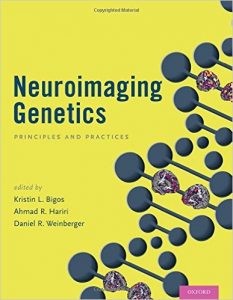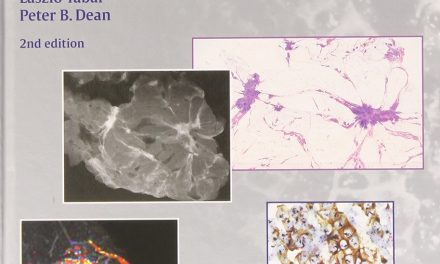 Editors: Kristin L. Bigos, Ahmad R. Hariri, and Daniel R. Weinberger
Editors: Kristin L. Bigos, Ahmad R. Hariri, and Daniel R. Weinberger
Publisher: Oxford University Press – 416 pages
Book Review by: Nano Khilnani
This book reviews the basic principles of neuroimaging techniques and their application to imaging genetics.
The field of neuroimaging genetics has grown rapidly in the last 20 years up to today in 2016. The editors point out in the first chapter that more than 20,000 articles have been published during that period on imaging genetics (see www.pubmed.gov). These are in the areas of affective and cognitive neuroscience, neurology, neuropsychiatry, and psychiatry.
In the field of neuroimaging genetics, researchers study the genetic components of brain structure, neurochemistry, and functional differences in the living human brain. What has been achieved? These studies have:
- Identified mechanisms of risk for clinical syndromes
- Established biologic validation by elucidating mechanisms and pathways that confer genetic risk
- Found genes that contribute to structural and functional variation in brain circuits
In short, they have broadened and deepened our understanding of the role that neurogenetics plays on our brain and the entire system of nerves in our body. The knowledge gained has helped us not only fight, but prevent disease, particularly neurodegenerative disorders.
Sixty-five specialists in various fields – behavioral sciences, clinical and cognitive neurosciences (neurobiology, neurochemistry, etc.), computer sciences, psychiatry, psychology, psychotherapy, radiology, and others, from ten countries – Austria, Canada, Denmark, Germany, Italy, Norway, Sweden, Switzerland, the United Kingdom, and the United States – authored the 23 chapters of this book which are organized around eight Parts, namely:
- Imaging Genetics and Neurochemistry
- Imaging Genetics and Drug Discovery
- Imaging Genetics and Genetic Discovery
- Imaging Genetics and Disease
- Imaging Genetics and the Environment
- Imaging Genetics and Cognition
- Imaging Genetics of Cognitive Aging
- Imaging Genetics and Multi-Locus Models
Among other purposes, the editors write that this book
- Elaborates on examples of the application of imaging genetics to understand neurochemical systems and pathways
- Explores relationships between genetics and the structural and functional connectivity in the human brain
- Provides insights into mechanisms of risk for psychiatric and neurologic illness
Two important chapters that relate to disease that afflict people as they age, are chapter 21, Neurobiology and the Genetics of Cognitive Aging, and chapter 22, Neuroimaging Genetics and Alzheimer’s Disease:
Before reading chapter 21 which begins on page 327, I urge readers to turn to page 336 and take a look at the figure presented on it entitled Imaging Genetics in Cognitive Aging. This figure shows us how changes in the brain affect our cognition or thinking, and how Alzheimer’s disease makes our cognition progressively worse.
As to chapter 22 (pages 357 to 393) it is important to know that according to a Wikipedia article, up to 70 percent of dementia cases are accounted for by Alzheimer’s. This is a chronic neurodegenerative disease. It starts slowly but gets worse over time. The most common early symptom is difficulty remembering recent events. As the disease progresses, the people who have it have difficulty recognizing where they are, or uttering their thoughts and feelings to the ones around them.
Some Alzheimer’s disease sufferers get lost and cannot figure out how to get to where they were headed or even to get back to where they started from. As their nerves worsen, its victims withdraw from contact with family, lose their bodily functions, and ultimately die. Importantly, the author of this article notes: The genetic heritability of Alzheimer’s disease (and memory components thereof), based on reviews of twin and family studies, range from 49 to 79 percent.
Chapter 22 helps us understand the relationship between neuroimaging genetics and Alzheimer’s disease, a debilitating real-life disease that may have adversely affected someone we know, perhaps a relative or friend. The entire book is a valuable read because it throws light upon a subject that is generally little known: neurogenetics
Editors:
Kristin L. Bigos, PhD is affiliated with the Division of Clinical Pharmacology and Phrmacogenetics at Lieber Institute for Brain Development. and with the Department of Medicine, Divison of Clinical Pharmacology, and Department of Psychiatry and Behavioral Sciences at Johns Hopkins School of Medicine in Baltimore, Maryland.
Ahmad R. Hariri, PhD is affiliated with the Department of Psychology and Neuroscience at Duke University in Durham, North Carolina.
Daniel R. Weinberger, MD is affiliated with the Lieber Institute for Brain Development; and with the Departments of Psychiatry and Behavioral Sciences, Neurology, and Neurosciences; and the McKusick-Nathans Institute of Genetic Medicine at Johns Hopkins School of Medicine in Baltimore, Maryland.







